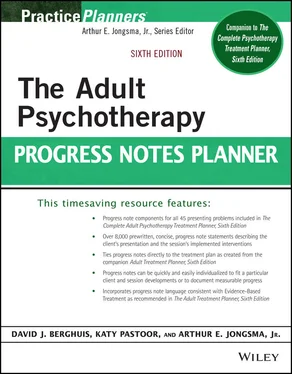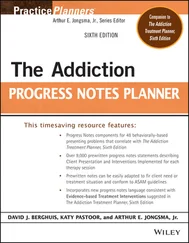8 Assess for Correlated Disorders (8)The client was assessed for evidence of research-based correlated disorders.The client was assessed in regard to his/her/their level of vulnerability to suicide.The client was identified as having a comorbid disorder, and treatment was adjusted to account for these concerns.The client has been assessed for any correlated disorders, but none were found.
9 Assess for Culturally Based Confounding Issues (9)The client was assessed for age-related issues that could help to better understand his/her/their clinical presentation.The client was assessed for gender-related issues that could help to better understand his/her/their clinical presentation.The client was assessed for cultural syndromes, cultural idioms of distress, or culturally based perceived causes that could help to better understand his/her/their clinical presentation.Alternative factors have been identified as contributing to the client's currently defined “problem behavior,” and these were taken into account in regard to his/her/their treatment.Culturally based factors that could help to account for the client's currently defined “problem behavior” were investigated, but no significant factors were identified.
10 Assess Severity of Impairment (10)The severity of the client's impairment was assessed to determine the appropriate level of care.The client was assessed in regard to his/her/their impairment in social, relational, vocational, and occupational endeavors.It was reflected to the client that his/her/their impairment appears to create mild to moderate effects on the client's functioning.It was reflected to the client that his/her/their impairment appears to create severe to very severe effects on the client's functioning.The client was continuously assessed for the severity of impairment, as well as the efficacy and appropriateness of treatment.
11 Explore Suicide Potential (11)The client's experience of suicidal urges and his/her/their history of suicidal behavior were explored.It was noted that the client has stated that he/she/they do experience suicidal urges but feel that they are clearly under his/her/their control and that there is no risk of engagement in suicidal behavior.The client identified suicidal urges as being present but contracted to contact others if the urges became strong.Because the client's suicidal urges were assessed to be very serious, immediate referral to a more intensive supervised level of care was made.Due to the client's suicidal urges, and his/her/their unwillingness to voluntarily self-admit to a more intensive, supervised level of care, involuntary commitment procedures were begun.
12 Monitor Ongoing Suicide Potential (12)The client was asked to report any suicidal urges or increase in the strength of these urges.The client stated that suicidal urges are diminishing and that they are under his/her/their control; he/she/they were praised for this progress.The client stated that he/she/they have no longer experienced thoughts of self-harm; he/she/they will continue to be monitored.The client stated that his/her/their suicide urges are strong and present a threat; a transfer to a more supervised setting was coordinated.
13 Refer for Hospitalization (13)Because the client was judged to be harmful to self, a referral was made for immediate hospitalization.The client was resistive to hospitalization for treatment of his/her/their suicide potential, so a commitment procedure was utilized.The client cooperated with hospitalization to treat the serious suicidal urges.
14 Refer to Medication Prescriber (14)A referral to a medication prescriber was made for the purpose of evaluating the client for a prescription for psychotropic medication.The client has followed through on a referral to a physician and has been assessed for a prescription of psychotropic medication.The client has been prescribed antidepressant medication.The client has refused the prescription of psychotropic medication prescribed by the physician.
15 Monitor Medication Adherence (15)As the client has taken the antidepressant medication prescribed by his/her/their prescriber, the effectiveness and side effects of the medication were monitored.The client reported that the antidepressant medication has been beneficial in reducing sleep interference and in stabilizing mood; the benefits of this progress were reviewed.The client reported that the antidepressant medication has not been beneficial; this was relayed to the prescribing clinician.The client was assessed for side effects from his/her/their medication.The client has not consistently taken the prescribed antidepressant medication and was redirected to do so.
16 Monitor Ability to Participate in Psychotherapy (16)The client's pattern of symptom improvement was monitored, with a focus on how stable he/she/they are in regard to participation in psychotherapy.The client was judged to be significantly improved and capable of participating in psychotherapy.The client was judged to still be too depressed to allow helpful participation in psychotherapy.
17 Educate About Mood Episodes (17)A variety of modalities were used to teach the family about signs and symptoms of the client's mood episodes.The phasic relapsing nature of the client's mood episodes was emphasized.The client's mood episode concerns were normalized.The client's mood episodes were destigmatized.
18 Teach Stress Diathesis Model (18)The client was taught a stress diathesis model of bipolar disorder.The biological predisposition to mood episodes was emphasized.The client was taught about how stress can make him/her/them more vulnerable to mood episodes.The manageability of mood episodes was emphasized.The client was reinforced for his/her/their clear understanding of the stress diathesis model of bipolar disorder.The client struggled to display a clear understanding of the stress diathesis model of bipolar disorder and was provided with additional remedial information in this area.
19 Provide Rationale for Treatment (19)The client was provided with a rationale for treatment involving ongoing medication and psychosocial treatment.The focus of treatment was emphasized, including recognizing, managing, and reducing biological psychological vulnerabilities that could precipitate relapse.A discussion was held about the rationale for treatment.The client was reinforced for his/her/their understanding of the appropriate rationale for treatment.The client was redirected when he/she/they displayed a poor understanding of the rationale for treatment.
20 Educate About Medication Adherence (20)The client was educated about the importance of medication adherence.The client was taught about the risk for relapse that occurs when medication is dis- continued.The client was asked to make a commitment to prescription adherence.The client was reinforced for his/her/their understanding and commitment to prescription adherence.The client was redirected when he/she/they displayed poor understanding or commitment to prescription adherence.
21 Assess Prescription Nonadherence Factors (21)Factors that have precipitated the client's prescription nonadherence were assessed.The client was checked for specific thoughts, feelings, and stressors that might con- tribute to his/her/their prescription nonadherence.The client was assigned “Why I Dislike Taking My Medication” from the Adult Psychotherapy Homework Planner (Jongsma).A plan was developed for recognizing and addressing the factors that have precipitated the client's prescription nonadherence.
22 Coordinate Group Psychoeducational Program (22)The client was admitted to a group psychoeducational program that teaches clients the psychological, biological, and social influences in the development of bipolar disorder.The client's involvement in the group psychoeducational program focused on the biological and psychological treatment of his/her/their disorder.The client has followed through on his/her/their involvement in a group psychoeducational program and key topics were reviewed.The client has not followed through on his/her/their involvement in a group psychoeducational program and was redirected to do so.
Читать дальше












